Study on the Countermeasures and Mechanism of Balanced Utilization in Multilayer Reservoirs at Ultra-High Water Cut Period
Abstract
:1. Introduction
2. Balanced Utilization Measures for Water Injection Development in Multilayer Reservoirs during the Ultra-High Water Cut Stage
- (1)
- Asynchronous injection production
- (2)
- Combined production by round injection
- (3)
- Cyclic injection and production
- (4)
- Separate injection and alternate mining
3. Study on Quantitative Physical Simulation of Interlayer Utilization Status
- (1)
- Saturated oil after saturated water of rock sample;
- (2)
- Well 4 is injected with water, and the oil production of the surrounding wells reaches 80~85% of the water content;
- (3)
- Well 4 is shut in, wells 3, 6, and 7 are converted to water injection, other wells are opened for production until the water content reaches 92~93%.
- (1)
- The relationship between measured resistance value and resistivity is obtained from the calibration curve of the resistivity and resistance relationship:where: Rt—oil-bearing resistivity of rock, Ω·m;Rt = AR − B
- R—resistance, kΩ;
- A, B—coefficient, dimensionless.
- (2)
- The resistivity of the formation is calculated, and the water saturation is calculated by the Archie formula:In the formula: R0—rock complete water resistivity, Ω·m;
- Sw—water saturation, %;
- So—oil saturation, %;
- b—coefficient, dimensionless;
- n—saturation index, dimensionless.
- (1)
- After the first stage of water drive, the remaining oil is mainly distributed in the upper and lower edge parts;
- (2)
- After the three-dimensional well pattern rotation injection and rotation production, the fluid flow changes direction, water channeling is reduced, and water injection sweep efficiency is expanded, which shows that the remaining oil is produced and the saturation of the remaining oil is significantly reduced. The displacement effect of remaining oil in the upper and lower edges of the 1000 mD large plate simulation model is obvious. The displacement effect of the upper part of the 300 mD large plate simulation model is good, while the displacement effect of the lower edge is weak.
4. Study on Quantitative Numerical Simulation of Interlayer Utilization Status
- The model has an inclination of 10° to the ground;
- Rock sample A is placed directly above rock sample B;
- The corresponding wells in rock sample AB are connected by a tee (A1 is connected with B1, A2 is connected with B2, and so on), so as to control the well opening and closing.
- Saturated oil after saturated water of rock sample;
- Well 4 is injected with water, and the oil production of the surrounding wells reaches 80~85% of the water content;
- Well 4 is shut in, Well 3, Well 6, and Well 7 are transferred to water injection, and other wells are opened for production until the water content reaches 92~93%.
- (1)
- Separate injection and alternate production
- (2)
- Cyclic injection and production
- (3)
- Combined production by round injection
- (4)
- Chemical plugging control
5. Conclusions and Suggestions
- (1)
- Large plate physical experiments:
- (2)
- Numerical simulation results:
- (3)
- Chemical plugging strategy:
Author Contributions
Funding
Data Availability Statement
Conflicts of Interest
References
- AlShalabi, E.W.; Sepehrnoori, K. A comprehensive review of low salinity/engineered water injections and their applications in sandstone and carbonate rocks. J. Petrol. Sci. Eng. 2016, 139, 137–161. [Google Scholar] [CrossRef]
- Alshehri, A.J.; Stanford, U.; Sagatov, E.; Kovscek, A.R. Pore-Level Mechanics of Forced and Spontaneous Imbibition of Aqueous Surfactant Solutions in Fractured Porous Media. In Proceedings of the SPE Annual Technical Conference and Exhibition, New Orleans, LA, USA, 4–7 October 2009. [Google Scholar] [CrossRef]
- Alves, D.R.; Carneiro, J.S.; Oliveira, I.F.; Façanha, F., Jr.; Santos, A.F.; Dariva, C.; Franceschi, E.; Fortuny, M. Influence of the salinity on the interfacial properties of a Brazilian crude oil–brine systems. Fuel 2014, 118, 21–26. [Google Scholar] [CrossRef]
- Amirian, T.; Haghighi, M.; Mostaghimi, P. Pore scale visualization of low salinity waterflooding as an enhanced oil recovery method. Energy Fuels 2017, 31, 13133–13143. [Google Scholar] [CrossRef]
- Amirian, T.; Haghighi, M. Impact of clay type and water composition on low salinity water injection—Visualization approach. APPEA J. 2018, 58, 51–59. [Google Scholar] [CrossRef]
- Austad, T.; RezaeiDoust, A.; Puntervold, T. Chemical Mechanism of Low Salinity Water Flooding in Sandstone Reservoirs. In Proceedings of the SPE Symposium on Improved Oil Recovery Conference, Tulsa, OK, USA, 24–28 April 2010. [Google Scholar]
- Geng, Z. Research on Vertical Equilibrium Displacement Optimization of Multilayer Oil Reservoirs in Extra High Water Cut Stage; China University of Petroleum (East China): Qingdao, China, 2013. [Google Scholar]
- Wang, S.; Niu, Z. Research on Subdivided Layer Series in the Late High Water Cut Stage of Complex Fault Block Reservoirs with Multiple Oil Layers in Dongxin Oilfield. Pet. Explor. Prod. 2004, 31, 116–118. [Google Scholar]
- Bao, J.; Song, X.; Ye, J.; Wang, J. Reorganization of High Water Cut Oilfield Development Layer Series. Xinjiang Pet. Geol. 2010, 31, 291–294. [Google Scholar]
- Shu, S. Research on the Reconstruction Technology of Subdivision Well Network in the Z Block of Lamadian Oilfield during the Extra High Water Cut Period; Northeast Petroleum University: Daqing, China, 2016. [Google Scholar]
- Sorbie, K.S. Gel Placement in Heterogeneous Systems With Crossflow. In Proceedings of the SPE/DOE Enhanced Oil Recovery Symposium, Society of Petroleum Engineers, Tulsa, OK, USA, 21–24 April 1992. [Google Scholar]
- Gao, H.W.; Chang, M.M.; Burchfield, T.E.; Tham, M.K. Permeability Modification Simulator Studies of Polymer-Gel-Treatment Initiation Time and Crossflow Effects on Waterflood Oil Recovery. SPE Reserv. Eng. 1993, 8, 221–227. [Google Scholar] [CrossRef]
- Wang, Y.; Liu, Y.; Deng, Q. Current situation and development strategy of the extra-high water cuts tage of continental facies oilfields in China. J. Northeast Pet. Univ. 2014, 38, 1–9. [Google Scholar]
- Li, Q.; Han, Y.; Liu, X.; Ansari, U.; Cheng, Y.; Yan, C. Hydrate as a by-product in CO2 leakage during the long-term sub-seabed sequestration and its role in preventing further leakage. Environ. Sci. Pollut. Res. 2022, 29, 77737–77754. [Google Scholar] [CrossRef] [PubMed]
- Yong, W.; Jiang, H.; Li, J. Study on water injection indicator curve model in fractured vuggy carbonate reservoir. Geofluids 2021, 2021, 5624642. [Google Scholar] [CrossRef]
- Muskat, M. The Flow of Homogeneous Fluids through Porous Media; McGrawhill: New York, NY, USA, 1937; pp. 9–150. [Google Scholar]
- Christman, P.G. Modeling the efforts of infill drilling and pattern modification in discontinuous reservoirs. SPE Reserv. Eng. 1995, 10, 4–9. [Google Scholar] [CrossRef]
- Collings, R.C.; Hild, G.P.; Abidi, H.R. Pattern modification by injection well shut-in: A combined cost reduction and sweep improvement effort. SPE Reserv. Eng. 1996, 11, 69–72. [Google Scholar] [CrossRef]
- Stirpe, M.T.; Guzman, J.; Manrique, E.; Alvarado, V. Cyclic Water Injection Simulations for Evaluations of its Potential in Lagocinco Field. In Proceedings of the SPE Improved Oil Recovery Conference, Tulsa, OK, USA, 17–21 April 2004. [Google Scholar]
- Li, Q.; Wang, F.; Wang, Y.; Forson, K.; Cao, L.; Zhang, C.; Zhou, C.; Zhao, B.; Chen, J. Experimental investigation on the high-pressure sand suspension and adsorption capacity of guar gum fracturing fluid in low-permeability shale reservoirs: Factor analysis and mechanism disclosure. Environ. Sci. Pollut. Res. 2022, 29, 53050–53062. [Google Scholar] [CrossRef] [PubMed]
- Surguchev, L.; Giske, N.H.; Kollbotn, L.; Shchipanov, A. Cyclic Water Injection Improves Oil Production in Carbonate Reservoir. J. Biol. Chem. 2008, 286, 3129–3138. [Google Scholar]
- Yu, F.; Jiang, H.; Xu, F.; Fan, Z.; Su, H.; Li, J. New insights into flow physics in the EOR process based on 2.5D reservoir micromodels. J. Pet. Sci. Eng. 2019, 181, 106214. [Google Scholar] [CrossRef]
- Wang, H.; Oyenowo, O.P.; Okuno, R. Aqueous formate solution for enhanced water imbibition in oil recovery and carbon storage in carbonate reservoirs. Fuel A J. Fuel Sci. 2023, 345, 128198. [Google Scholar] [CrossRef]
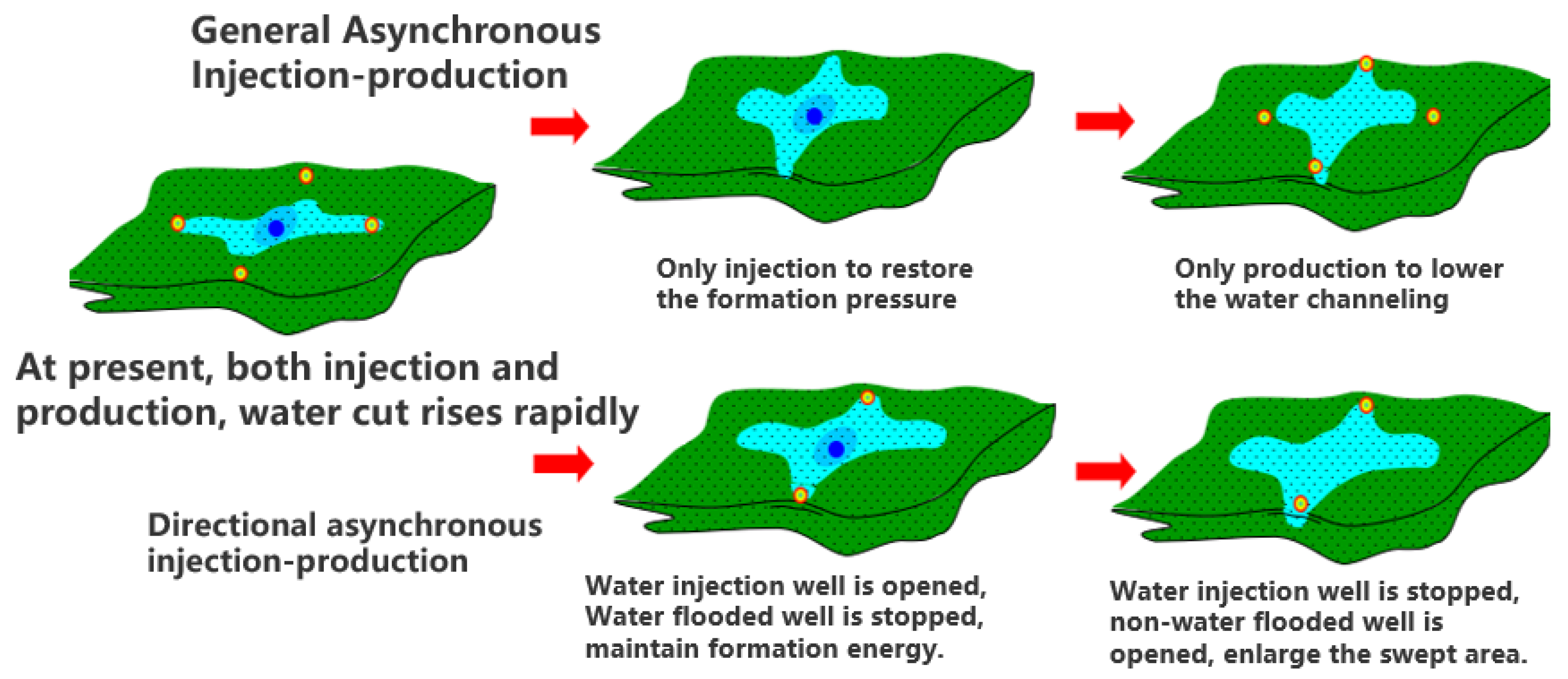

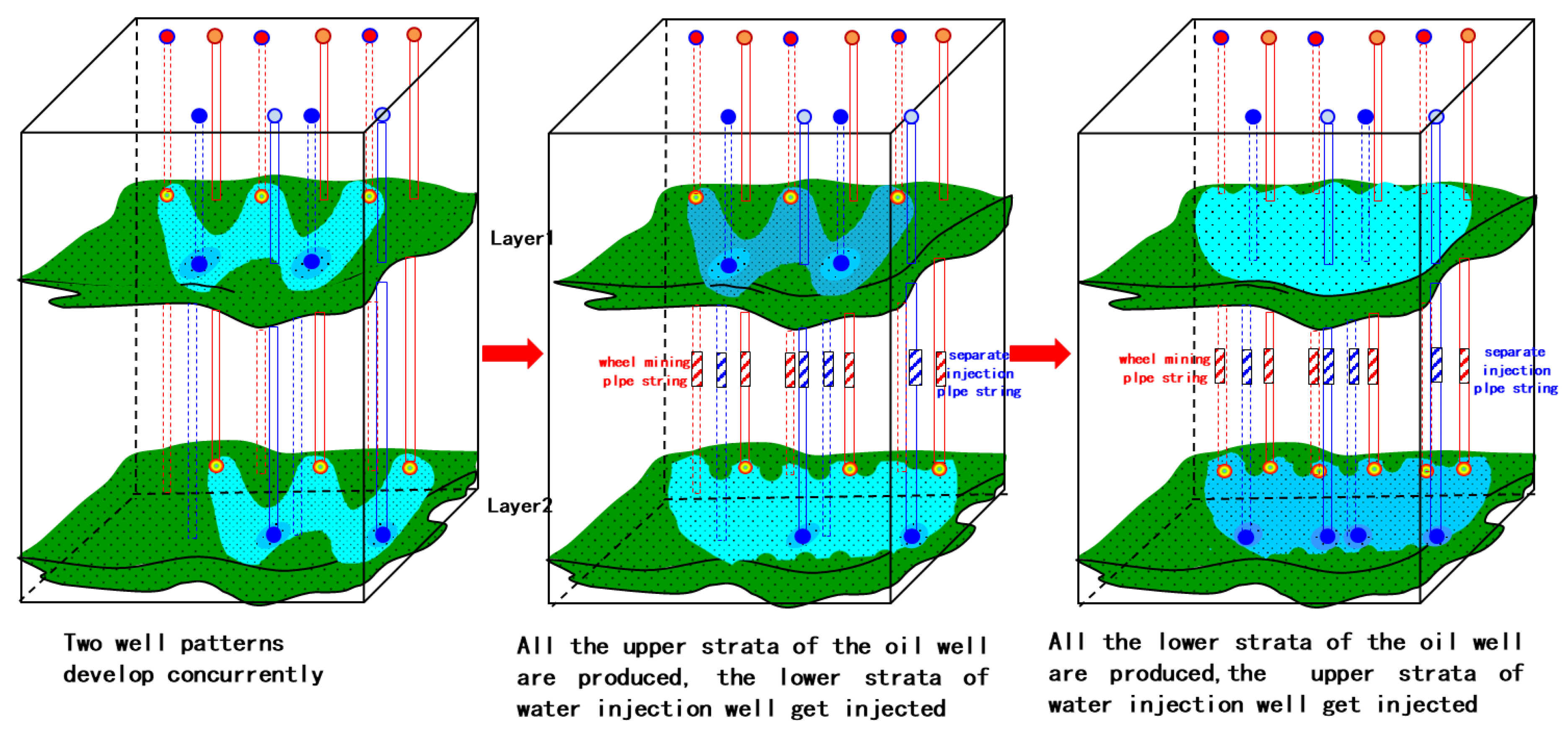
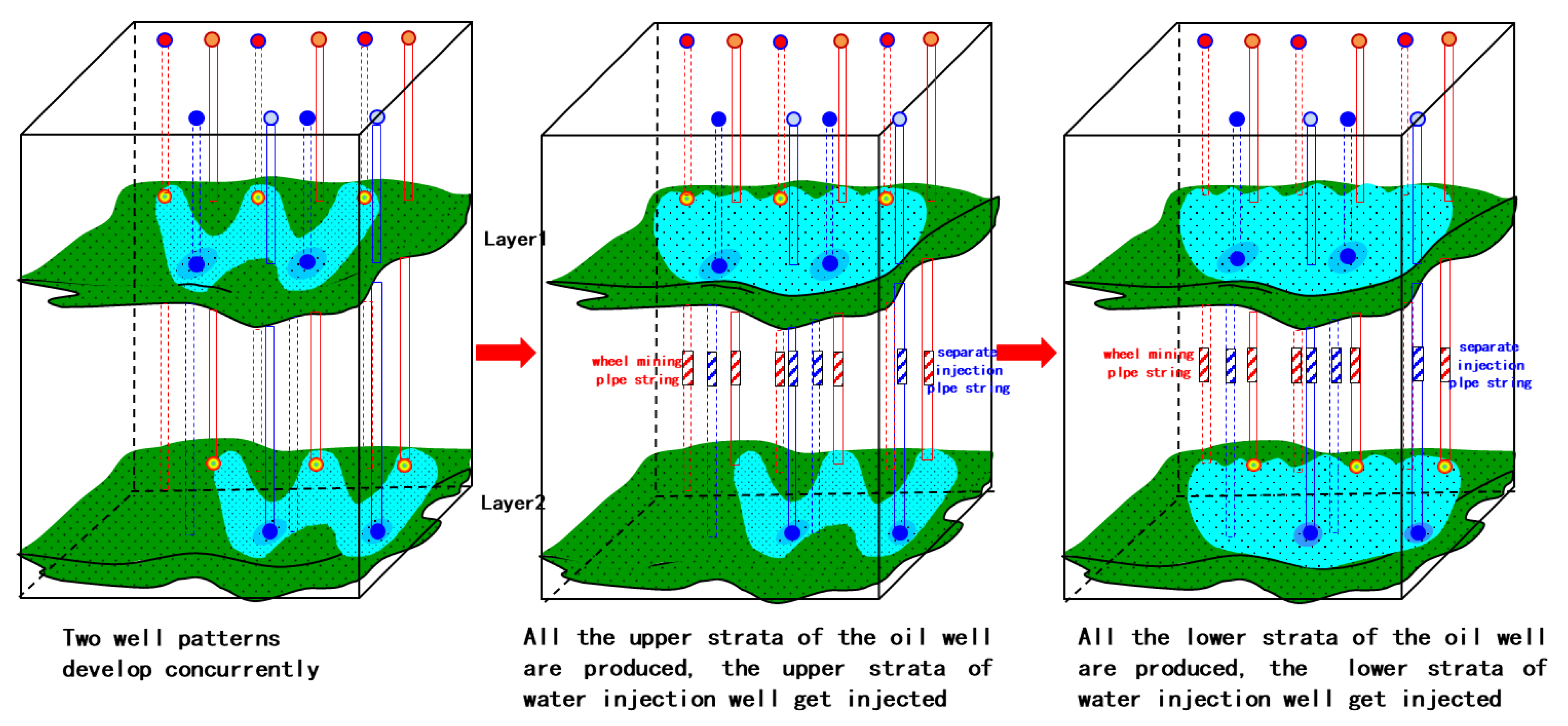
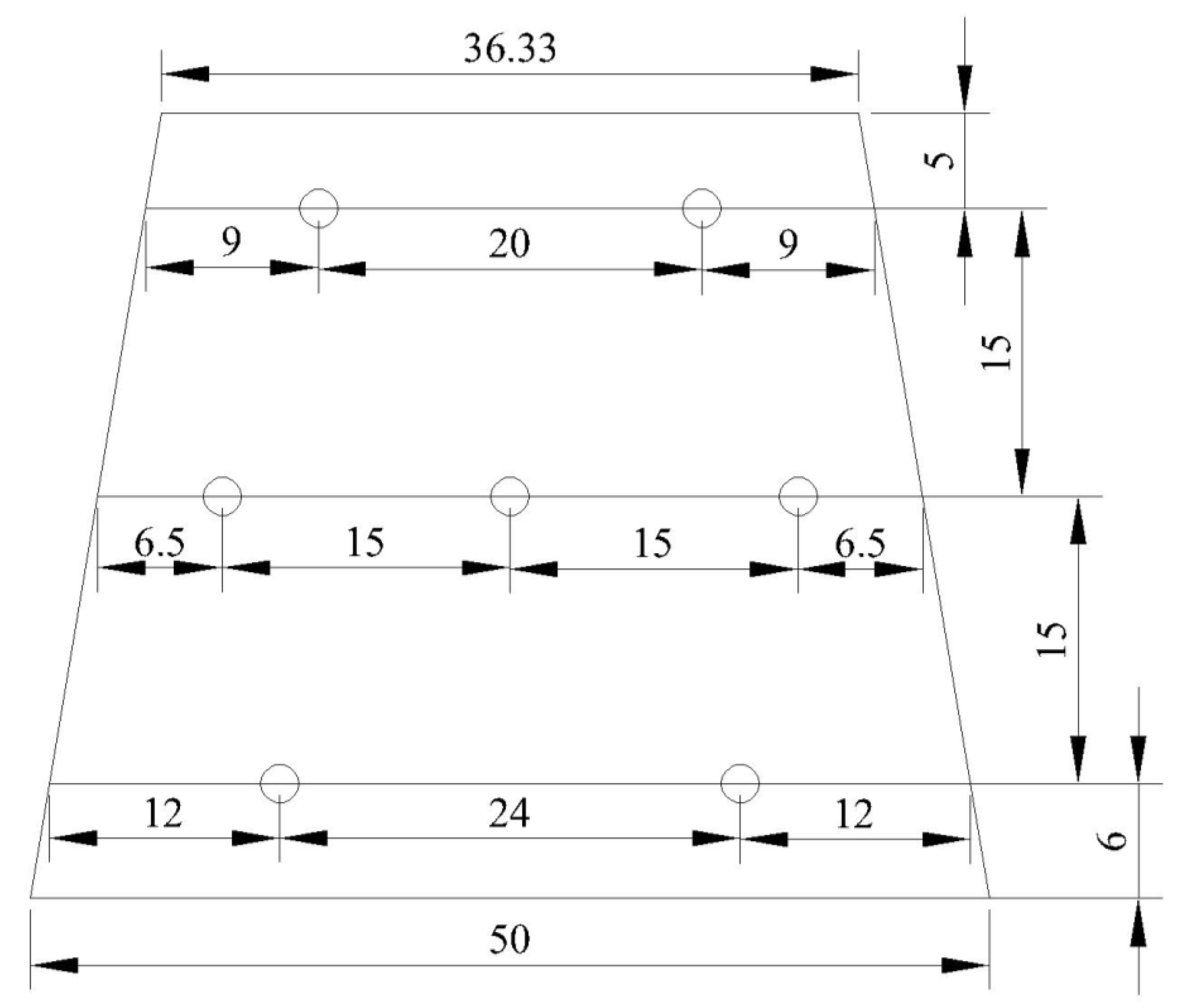

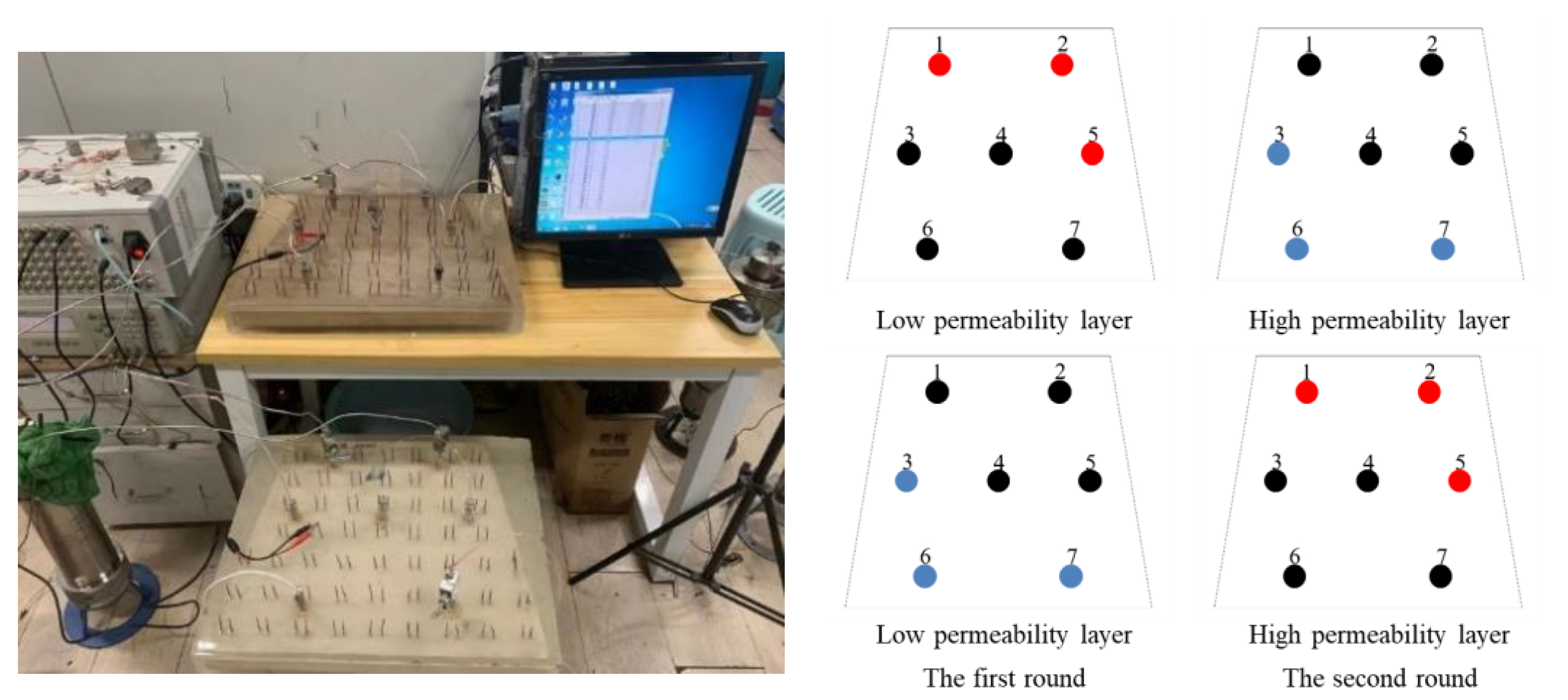
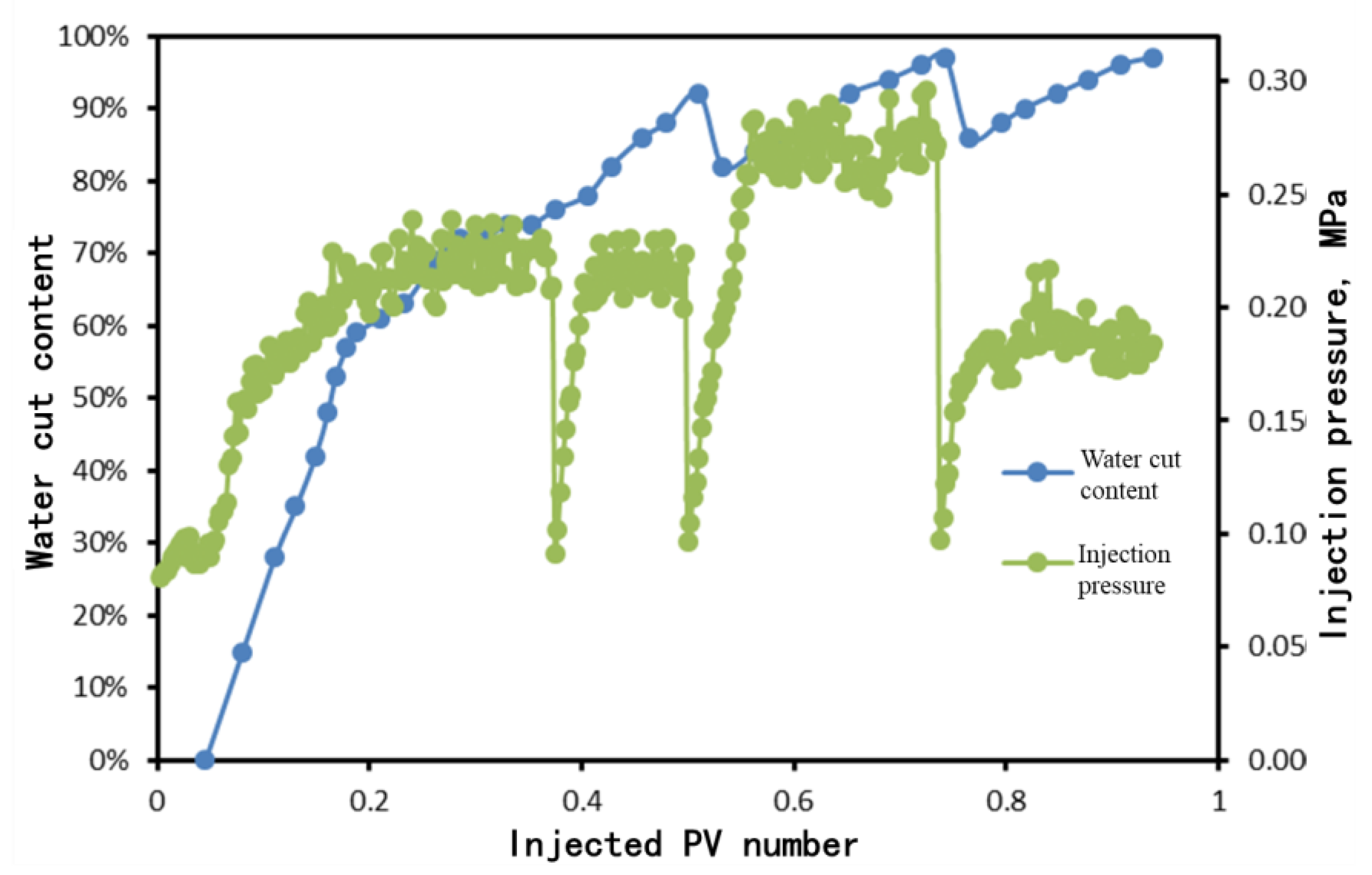

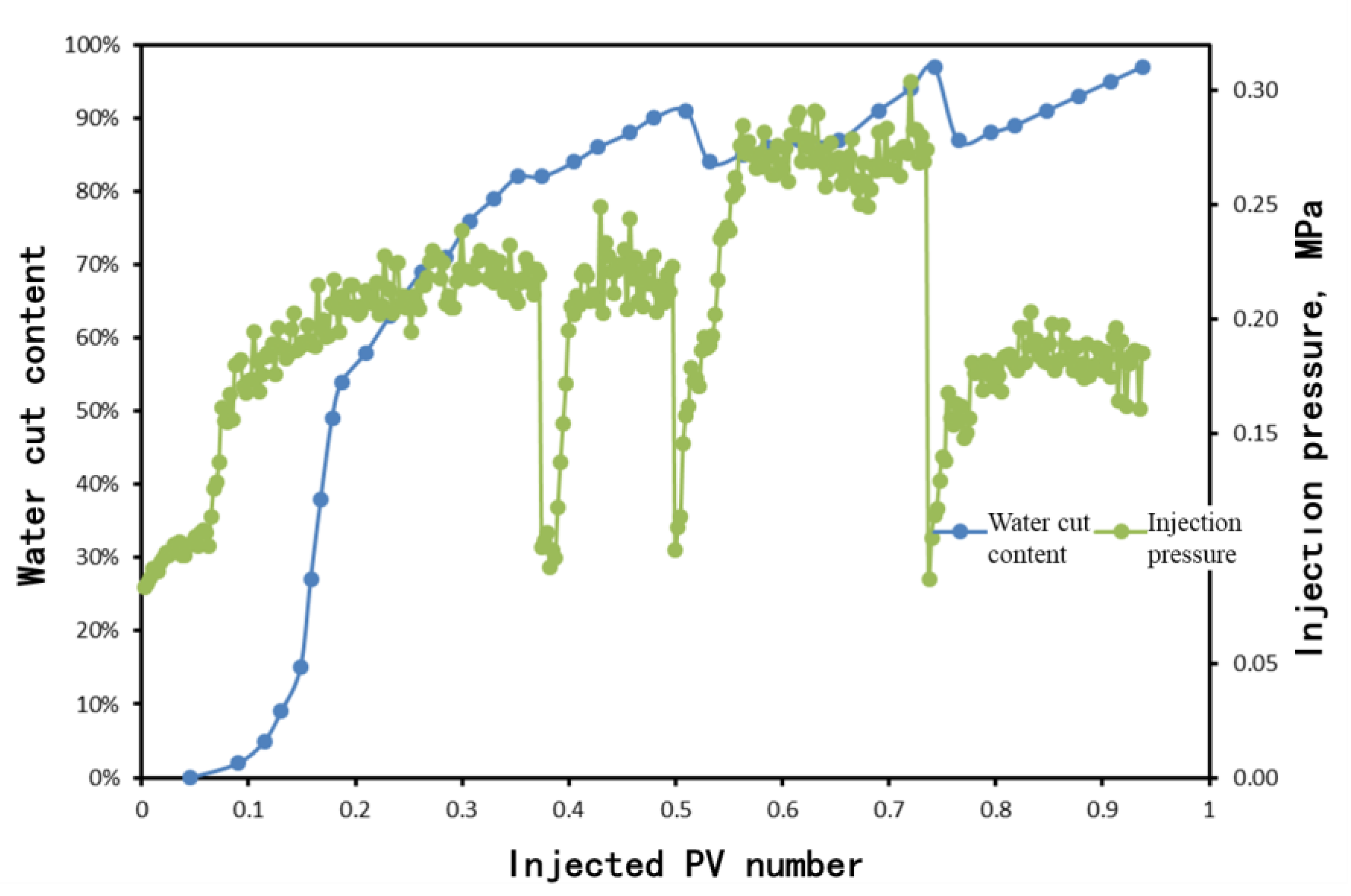
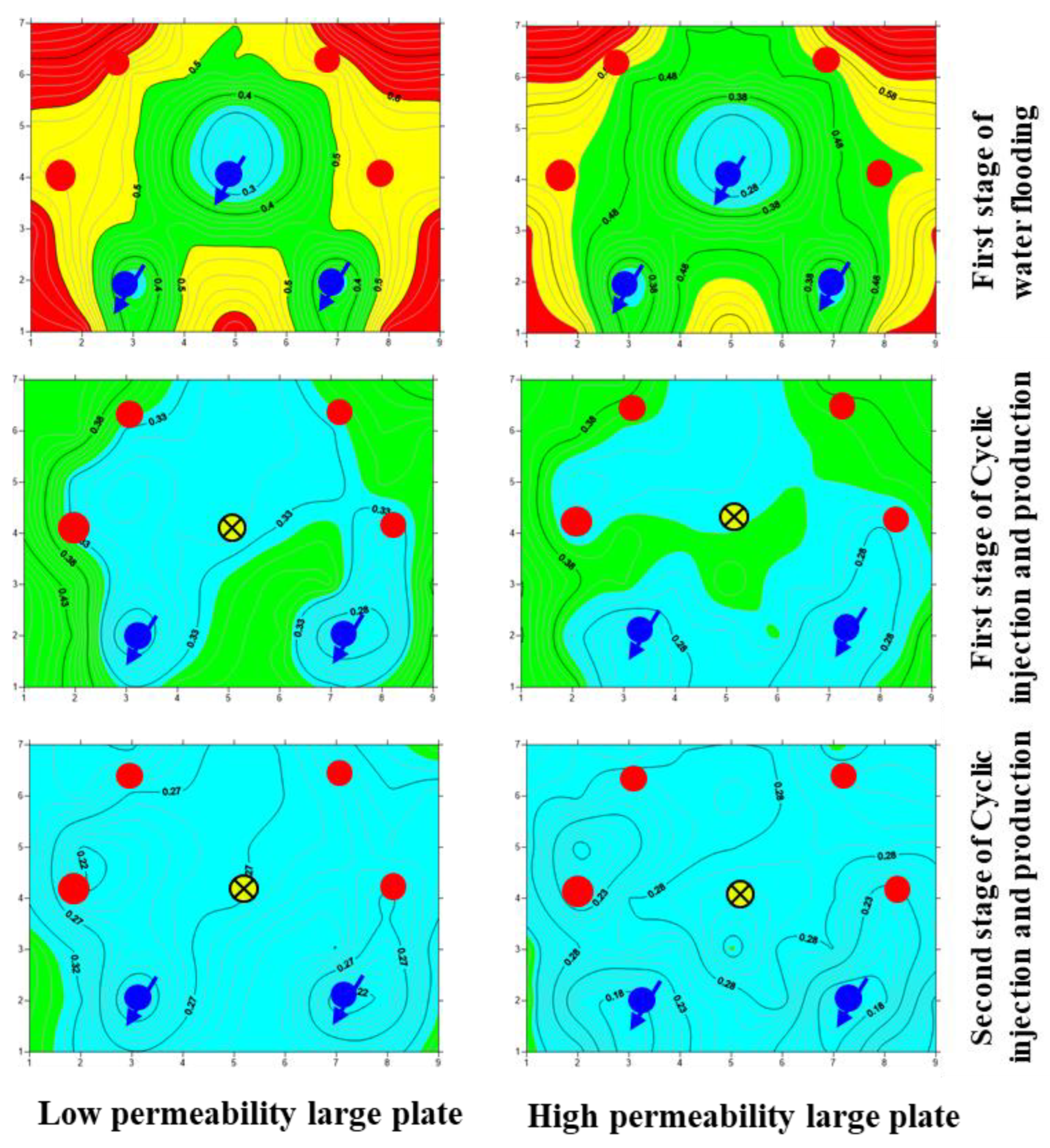




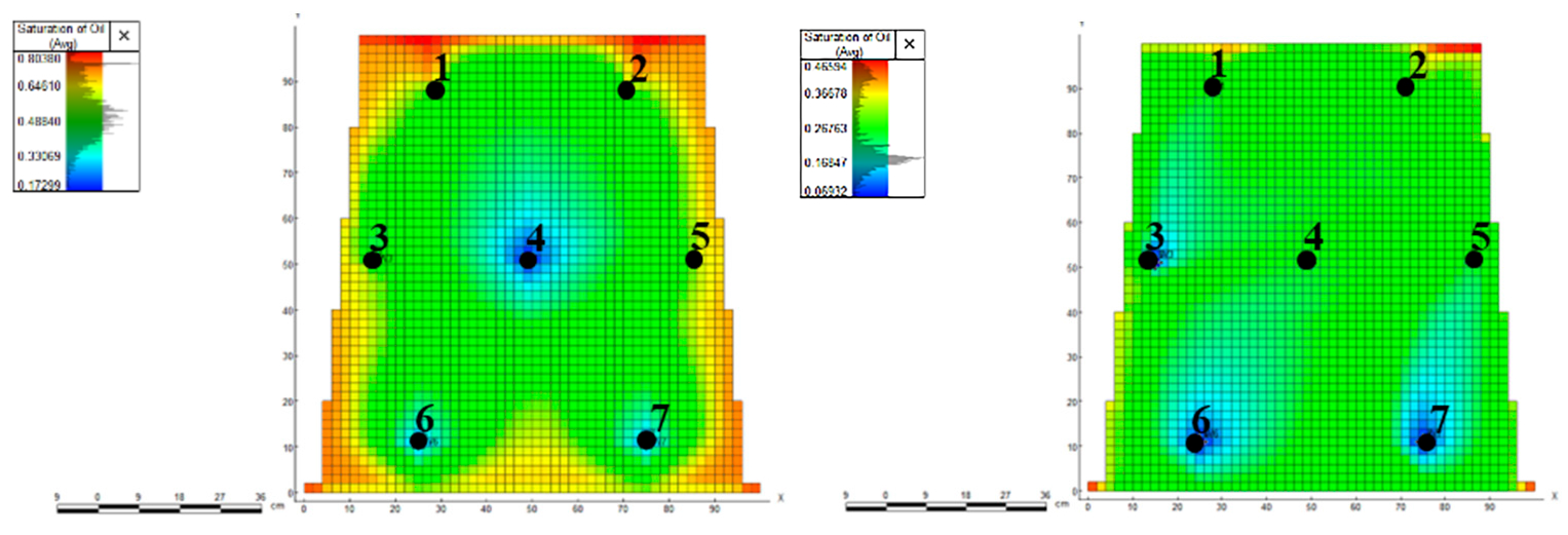



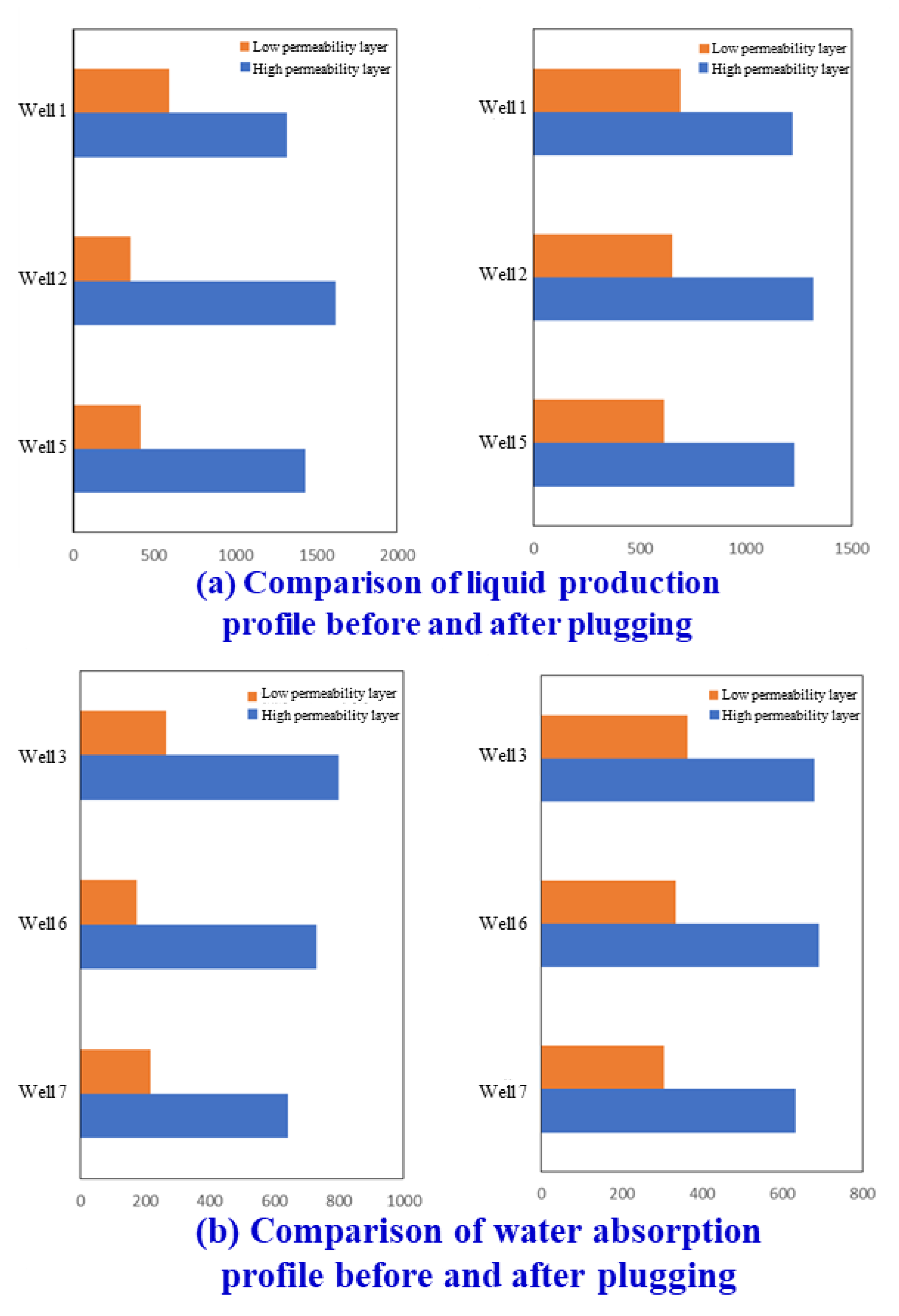
| Grouping | Recovery Efficiency of the First Stage of Water Drive | Ultimate Recovery | Recovery Rate Improvement Value |
|---|---|---|---|
| 300 mD large plate | 39.32% | 49.01% | 9.69% |
| 1000 mD large plate | 41.62% | 52.13% | 10.51% |
| Cumulative Oil Production of Water Gut Reaching 98%, Scc (Ordinary Water Injection) | Cumulative Oil Production of Water Cut Reaching 98%, Scc (Sub-Cycle Injection Production) | Oil Recovery (Ordinary Water Injection) | Oil Recovery (Sub-Cycle Injection Production) | |
|---|---|---|---|---|
| Well 1 | 809.34 | 766.15 | 7.38% | 6.35% |
| Well 2 | 802.79 | 912.63 | 7.36% | 10.24% |
| Well 5 | 725.86 | 798.99 | 6.88% | 7.12% |
| Cumulative Oil Production of Water Gut Reaching 98%, Scc (Ordinary Water Injection) | Cumulative Oil Production of Water Cut Reaching 98%, Scc (Sub-Cycle Injection Production) | Oil Recovery (Ordinary Water Injection) | Oil Recovery (Sub-Cycle Injection Production) | |
|---|---|---|---|---|
| Well 1 | 809.34 | 967.23 | 7.38% | 11.32% |
| Well 2 | 802.79 | 955.73 | 7.36% | 10.56% |
| Well 5 | 725.86 | 600.50 | 6.88% | 5.41% |
| Cumulative Oil Production of Water Cut Reaching 98%, Scc (Ordinary Water Injection) | Cumulative Oil Production of Water Cut Reaching 98%, Scc (Sub-Cycle Injection Production) | Oil Recovery (Ordinary Water Injection) | Oil Recovery (Sub-Cycle Injection Production) | |
|---|---|---|---|---|
| Well 1 | 809.34 | 913.54 | 7.38% | 9.82% |
| Well 2 | 802.79 | 961.84 | 7.36% | 9.91% |
| Well 5 | 725.86 | 772.36 | 6.88% | 6.95% |
Disclaimer/Publisher’s Note: The statements, opinions and data contained in all publications are solely those of the individual author(s) and contributor(s) and not of MDPI and/or the editor(s). MDPI and/or the editor(s) disclaim responsibility for any injury to people or property resulting from any ideas, methods, instructions or products referred to in the content. |
© 2023 by the authors. Licensee MDPI, Basel, Switzerland. This article is an open access article distributed under the terms and conditions of the Creative Commons Attribution (CC BY) license (https://creativecommons.org/licenses/by/4.0/).
Share and Cite
Wang, Y.; Jiang, H.; Wang, Z.; Diwu, P.; Li, J. Study on the Countermeasures and Mechanism of Balanced Utilization in Multilayer Reservoirs at Ultra-High Water Cut Period. Processes 2023, 11, 3111. https://doi.org/10.3390/pr11113111
Wang Y, Jiang H, Wang Z, Diwu P, Li J. Study on the Countermeasures and Mechanism of Balanced Utilization in Multilayer Reservoirs at Ultra-High Water Cut Period. Processes. 2023; 11(11):3111. https://doi.org/10.3390/pr11113111
Chicago/Turabian StyleWang, Yong, Hanqiao Jiang, Zhiqiang Wang, Pengxiang Diwu, and Junjian Li. 2023. "Study on the Countermeasures and Mechanism of Balanced Utilization in Multilayer Reservoirs at Ultra-High Water Cut Period" Processes 11, no. 11: 3111. https://doi.org/10.3390/pr11113111





